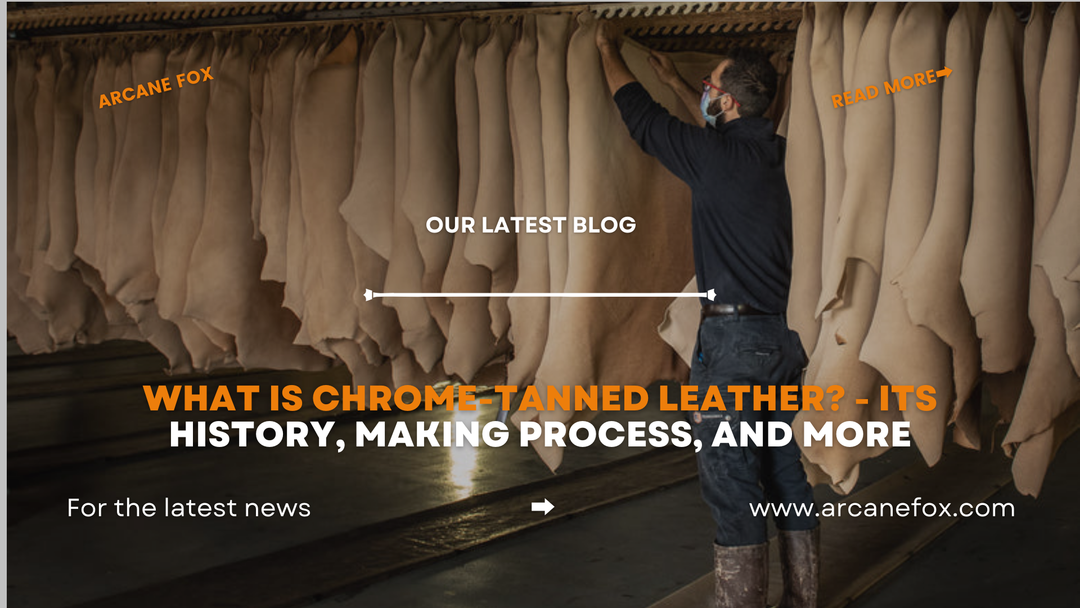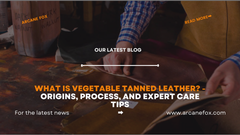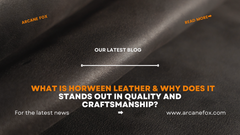What is Chrome-Tanned Leather? - Its History, Making Process, and More

What is Chrome-Tanned Leather? - Its History, Making Process, and More
Chrome-tanned leather is among the most popular types of leather in use today, making up nearly 90% of global leather production. This leather stands out for its softness, flexibility, and vibrant colors. Unlike vegetable-tanned leather, which can take months to produce, chrome tanning is a much quicker process, taking just a few days.
So, what exactly makes chrome-tanned leather so popular? In this post, we'll explore what chrome tanning is, how the process works, and its rich history. We’ll also discuss the advantages and disadvantages of chrome-tanned leather. Whether you’re a seasoned leather crafter or simply curious, this guide will help you appreciate its unique qualities and understand why it’s used in products ranging from bags to upholstery. We'll also share essential care tips for maintaining chrome-tanned leather.
1. What is Chrome-Tanned Leather?

Leather that has been darkened with chromium salts is called chrome tanned leather. Chrome salts make it possible to tan leather in just two days, which is much faster than other tanning processes. The leather that is made is soft, flexible, and won't get wet. Chrome-tanned leather can come from any animal because chrome tanning is just a way of tanning.
- Cow
- Sheep
- Horse
- Others
2. The History of Chrome Tanned Leather

Before chrome tanning, almost all leather was colored with plants. Tree bark that is high in tannins is used to tan Veg tan leather. It takes months to tan an animal hide because it requires a lot of work and time.
Around the middle of the 1800s, scientists were looking for ways to make leather without dyeing it. Frederick Knapp found out at this time that chromium could be used to make leather brown. Chrome salts made it possible to tan animal hides in days instead of months. The leather that was made is plush, strong, long-lasting, and better at keeping out water than regular green tan leather.
Chrome tan leather and synthetic dyes became more popular in the late 1800s. This made it possible to paint the leather in much brighter colors than veg tan leather. It also met the needs for new ideas during the industrial revolution because it could be made faster.
Chrome-tanned leather makes up almost 90% of all leather made these days. It can be used for almost anything, such as:
- Upholstery
- Jackets
- Boots
- Handbags
3. Clearing Up Myths & Misconceptions

One prevalent misperception regarding chrome-tanned leather is that it lacks the same level of durability as vegetable-tanned leather. This is quite true. Actually, during the past 160 years, the technique of producing chrome tanned leather has gotten fairly sophisticated; the resulting leather is quite durable and used everywhere, from the shoe and apparel sectors to the automotive sector.
Although veg tan leather is preferred among many leather craftspeople — especially for tooling — chrome tanned leather has several benefits, such being more supple yet having incredibly good tensile strength compared to the same thickness of veg tan leather.
Since chrome tanned leather counts for almost 90% of all leather manufactured, most leather goods are actually created from this type of leather. More often than not, the quality of the hide determines the leather's durability rather than tanning technique.
4. How Chrome Tanned Leather is Made?

The process of creating chrome-tanned leather, much like vegetable-tanned leather, begins with treating the animal hide to remove its hair. After removing the hair, you thoroughly clean the hides and subject them to a series of baths.
In the first bath, you lower the pH level of the hide, a crucial step to ensure that the chrome salts are uniformly and consistently absorbed. This part of the process is called "pickling."
After pickling, you place the hide into a chromium tanning solution to stabilize it. The chrome binds to the collagen fibers within the hide, effectively preventing decomposition.
Once stabilized, the leather develops a bluish tint from the chrome salts. You then proceed to clean, neutralize, wring, and place the leather into a drum for dyeing.
Next, the leather undergoes "fatliquoring," where you reintroduce oils into the hide to replenish the fats lost during tanning. This step, which industry data links to air pollutant emissions from the Food and Agriculture Industry, involves placing the leather into a heated drum of oil for about 30 minutes. Afterward, you wring and leave the leather to dry.
At this point, you can apply additional treatments to the leather, such as grain correction or various finishes. The entire chrome tanning process takes only one to two days, a stark contrast to vegetable tanning, which can take months to complete.
4.1 Production Statistics of Chrome Tanned Leather
- Volume per year: 52,9109 Tons Annually
- Key producing countries: India, Brazil, Saudi Arabia
- Biggest exporting country: India
- Biggest importing country: Italy

4.2 Cost of Chrome Tanned Leather
- Per Square Foot: $2–$7
- Half Hide: $120–$360
- Full Hide: $60–$180

4.3 When to Use Chrome Tanned Leather for Leathercraft
Consider using chrome-tanned leather when:
- You’re seeking leather that is soft and flexible.
- You want vibrant, bright colors that fully penetrate the hide.
- Your product will be exposed to water since chrome-tanned leather offers superior water resistance.

4.4 Tips for Leather Crafting With Chrome Tanned Leather
- It’s a good idea to use edge paint instead of burnishing tools, as chrome-tanned leather doesn’t respond well to burnishing.
- When hand sewing, be mindful to maintain even tension on your thread. Chrome-tanned leather is thinner, which means it can become wavy if the tension is uneven.
- Take your time when cutting the leather, and use a straight edge for precision. Since chrome-tanned leather is softer and more malleable than vegetable-tanned leather, it requires careful handling during cutting.

5. In-depth Characteristics of Chrome Tanned Leather
Chrome-tanned leather stands out for its softness, flexibility, and durability. Let’s explore the key features that make this leather a top choice for both everyday products and leathercraft projects.
5.1 Natural or Synthetic
Chrome-tanned leather is a natural material. The term "chrome tanning" refers to the process used to tan animal hides, and it can be made from the hides of various animals, including:
- Bovine (cows)
- Equine (horses)
- Goat
- Pig
5.2 Surface Texture
One of the standout features of chrome-tanned leather is its incredible softness and suppleness. The surface texture can vary greatly depending on the finishing process. It can be grain corrected, pebbled, or even coated, offering a wide range of textures for different applications.
5.3 Available Thickness
Unlike vegetable-tanned leather, chrome-tanned leather is generally found in lighter weights, typically between 2 to 5 ounces, though it can reach up to 8 ounces in some cases. This lighter weight makes it an excellent choice for crafting items such as bags, shoes, and accessories, where flexibility and lightweight material are essential.

5.4 Largest Workable Size
Since chrome tanning is a process that can be applied to any animal hide, the workable size of the leather is limited by the size of the animal itself. For example, a large cowhide can measure up to 60 square feet, providing ample material for larger leather projects.
5.5 Flexibility
Chrome-tanned leather offers incredible flexibility, especially compared to vegetable-tanned leather. However, the final finishing process and the type of animal used influence its degree of flexibility.
5.6 Softness
Generally speaking, chrome-tanned leather is regarded as extremely soft. However, this quality can vary based on the type of animal used. While cow and horse hides tend to be less soft, leathers made from lambskin or deerskin are exceptionally supple. Remember, chrome tanning refers only to the tanning method, so softness is largely determined by the animal.

5.7 Sewability
When compared to vegetable-tanned leather, chrome-tanned leather is much easier to sew. Its softness and flexibility allow it to be sewn on lighter-weight machines or punched by hand without difficulty. This can vary depending on the thickness of the leather and the animal hide used, but typical chrome-tanned cowhide is significantly more flexible than vegetable-tanned leather.
5.8 Durability
Chrome-tanned leather is highly durable, making it a popular choice for long-lasting goods. The chrome salts used during the tanning process impart water resistance, making it more resilient than vegetable-tanned leather. Although it is a natural material and needs periodic conditioning, chrome-tanned leather frequently creates heirloom-quality items designed to last a lifetime.
5.9 Ease of Maintenance
This type of leather is relatively low-maintenance. Like most leathers, it can be cleaned with mild leather soap and conditioned using leather conditioners to maintain its appearance and longevity. Its durability ensures that it holds up well over time with minimal effort.
5.10 Lifespan With Daily Use
Chrome-tanned leather is make to last. When cared for properly, it can endure daily use for decades. Even with minimal maintenance, it can still last a remarkably long time, making it an excellent investment for high-quality leather goods.

5.11 Available Colors
One of the advantages of chrome-tanned leather is its ability to take on virtually any color. Since most chrome-tanned leather is drum-dyed during the tanning process, the dye penetrates the entire hide. This means the color is more permanent and colorfast, unlike vegetable-tanned leather, which can develop a patina or lose its vibrancy over time.
5.12 Waterproofness
Although not completely waterproof, chrome-tanned leather is far more water-resistant than vegetable-tanned leather. The chrome salts used during the tanning process help the leather repel water, preventing it from absorbing moisture as quickly. However, because it is still a natural material, it’s advisable to condition the leather regularly to maintain its water resistance.
5.13 Cost
One of the key reasons chrome-tanned leather is so widely used is its affordability. The process of tanning a hide using chrome takes just two days, which significantly reduces production costs compared to vegetable-tanned leather, which can take months to process. Typically, chrome-tanned leather costs between $2 and $7 per square foot, making it an attractive option for both large-scale production and individual crafters.
5.14 Ease of Crafting
Chrome-tanned leather's softness and flexibility make it much easier to work with than vegetable-tanned leather. It can be cut, sewn, and shaped with ease, making it a preferred choice for projects requiring pliable material. This makes it ideal for crafting items such as:

5.15 Availability and Rarity of Chrome-Tanned Leather
Chrome-tanned leather isn't rare at all—it makes up about 90% of the leather produced globally today. If you own leather shoes, bags, or clothing, they are most likely made from chrome-tanned leather. Its rapid production time and cost-effectiveness contribute to its prevalence in the global leather market.
6. Pros and Cons of Chrome Tanned Leather

6.1 Pros
Chrome-tanned leather is versatile, offering exceptional softness, flexibility, and durability. Thanks to its dyeing process, it is available in a wide range of vibrant, colorfast shades that won’t fade over time. Its quick tanning process and water resistance make it ideal for producing a variety of leather goods, including:
- Bags
- Shoes
- Jackets
- Wallets
- Upholstery
6.2 Cons
Despite its many advantages, chrome-tanned leather has some drawbacks. The environmental impact of the chromium salts used in the process can be significant if not properly managed. It also lacks the natural aging qualities of vegetable-tanned leather, as it doesn’t develop a patina. Chrome-tanned leather is generally found in lighter weights, limiting its use for heavy-duty projects. Additionally, some crafters prefer the more natural, earthy feel of veg-tanned leather.
7. What is Chrome Tanned Leather Used For?

Chrome-tanned leather is widely used across various industries due to its versatility, durability, and ability to take on vibrant colors. The quick tanning process and the flexibility of the material make it an excellent choice for manufacturing a broad range of products. Some of the most common uses include:
- Footwear: Due to its softness, flexibility, and water resistance, chrome-tanned leather is a popular choice for shoes and boots. It molds comfortably to the foot while maintaining its shape and durability over time.
- Bags and Accessories: The lightweight nature of chrome-tanned leather makes it ideal for crafting handbags, wallets, belts, and other accessories. Its vibrant colors and smooth finish make it an attractive option for fashion items.
- Jackets and Clothing: Chrome-tanned leather’s soft texture and flexibility make it a favorite for leather jackets, gloves, and other clothing items. Its ability to retain vibrant colors ensures the leather remains visually appealing while offering comfort and weather resistance.
- Furniture Upholstery: Chrome-tanned leather is often used in furniture upholstery, providing a soft yet durable covering for sofas, chairs, and other home furnishings. Its water resistance and ease of maintenance make it a practical choice for everyday use.
- Automotive Interiors: The automotive industry frequently uses chrome-tanned leather for car seats and interior details, as it provides a luxurious feel and is resistant to wear and tear, while being easy to clean and maintain.
- Sporting Goods: Due to its strength and durability, chrome-tanned leather is often utilize in sports equipment like baseball gloves and other gear where flexibility and long-lasting wear are critical.
In summary, chrome-tanned leather is a versatile material that can be use in anything from fashion to furnishings. Its softness, flexibility, vibrant colors, and water-resistant properties make it a go-to choice for a wide array of leather goods.
8. Our Personal Research on Chrome Tanned Leather

I explored chrome-tanned leather by making a simple tote bag, curious to compare it to vegetable-tanned leather. I bought a 3–4 oz chrome-tanned cowhide and found it surprisingly easy to work with. Cutting was simple, though its flexibility meant I had to be careful with my straight edge to avoid slipping. The most challenging part was skiving, as the leather stretched under the knife and required extra patience.
Sewing was much faster, thanks to the softness of the leather, which allowed me to use a medium-weight sewing machine. Skiving before sewing also helped avoid bulky seams. Overall, chrome-tanned leather was softer, more flexible, and easier to work with than veg-tanned leather, although skiving was trickier.
For bags, chrome-tanned leather is my new go-to, but I’ll stick with veg-tanned for belts and wallets. I also plan to source leather from Italy or the U.S. to reduce the environmental impact of chrome tanning.
9. Chrome Tanned Leather Care and Maintenance

9.1 How To Clean Chrome Tanned Leather?
Cleaning chrome-tanned leather is straightforward and requires just water, leather soap, a soft bristle brush, and a lint-free rag.
- First, use a lint-free rag or soft bristle brush to remove any loose dirt.
- Next, apply a mild soap, such as saddle soap, to tackle stubborn dirt and stains.
- After lathering the leather, use a clean damp rag to wipe off the soap.
- Allow the leather to fully dry before moving on to conditioning.
9.2 How To Condition Chrome Tanned Leather?
After cleaning and drying the leather, apply a leather conditioner or cream. A cream works well as it rehydrates the leather, keeping it soft and flexible without altering the color.
- Take the conditioner and apply it to a clean rag.
- Gently rub it into the leather to ensure even coverage.
9.3 How To Store Chrome Tanned Leather?
Once cleaned and conditioned, store the item in a clean, lint-free bag to keep dust off. Always keep chrome-tanned leather goods away from heat and direct sunlight to prevent drying and preserve the color's vibrancy.
10. Final Thoughts
Chrome-tanned leather is an excellent option for crafters like me who need a material that is both strong and cost-effective for various leather goods. Its durability and flexibility make it ideal for projects such as bags, shoes, and jackets. While I recognize that vegetable-tanned leather is a more eco-friendly option due to its natural tanning process, chrome-tanned leather still has its place in my work. However, it's crucial to be mindful of where the leather is sourced, as the environmental impact of chrome tanning can vary greatly by country. To reduce my environmental footprint, I plan to continue using chrome-tanned leather but will focus on sourcing it from U.S. and Italian tanneries, which tend to follow more stringent environmental standards.
Related Posts:
- How is Leather Made? A Step-by-Step Guide of the Leather Tanning Process
- What is Vegetable Tanned Leather? - It's Origins, Process, and Expert Care Tips
- Leather 101 - The Ultimate Guide to Different Types of Leather
- What is full-grain leather? Everything You Need to Know
- What is Top Grain Leather? The Comprehensive Guide
- Is Genuine Leather a Real Leather? Quality, Durability, and More
- The Comprehensive Guide to Split Grain Leather - Definition, Varieties, and More
- What is The Difference Between Bonded Leather And Other Types of Leather
- What is Cowhide Leather? Origins, Types, and Maintenance
- What is Goatskin Leather? Different Types of Goatskin, Quality, Durability and More
- What is Sheepskin Leather? Everything You Need To Know
- What is Lambskin Leather? The Ultimate Guide on Quality, Durability and More
- What is Calfskin Leather? It's Quality & Durability Against Other Leather!
- What is Buffalo Leather? - It’s Uses, Care, and Comparison with Other Leather
- What is Horse Leather? - It's Durability, Uses, and Caring Tips
- What is Kangaroo Leather? & It’s Strength, Production, and Uses
- What is Pig Leather? & Why it is a Strong and Versatile Choice for Your Projects
- What is Deer Leather - It's Softness, Strength, and Different Types





